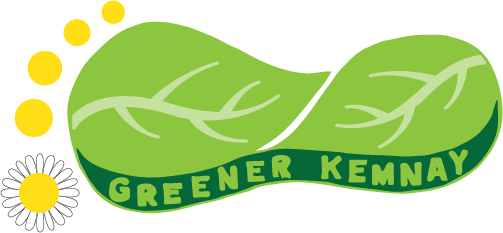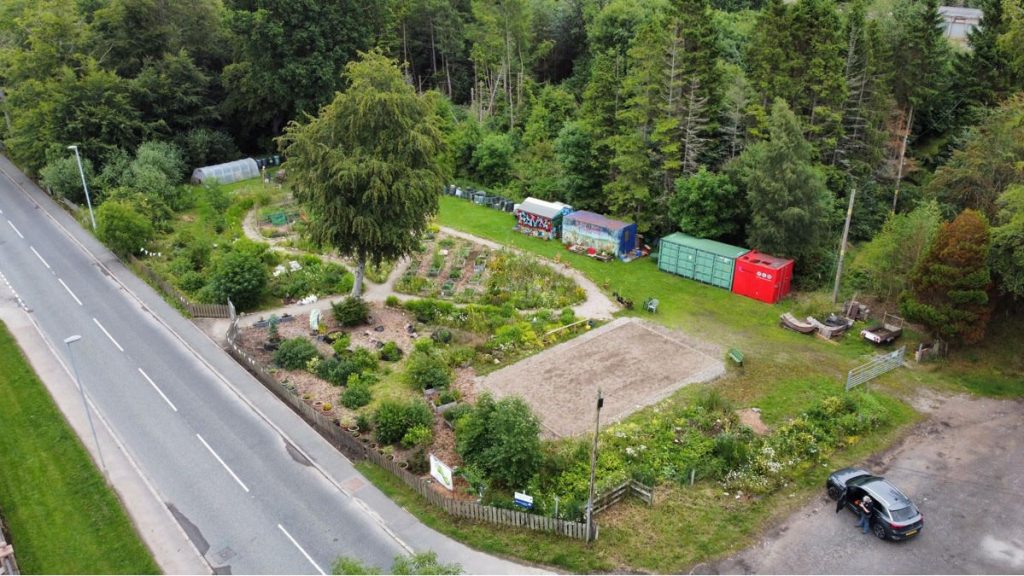
Recent pictures from the Community Garden.
Picking a Site
When Greener Kemnay looked around the village for a site for the Community Garden, Birley Bush was picked because; it was a space that is close to the village, not in an area for possible vandalism, rough ground that was not in use, big enough site that could fulfil our needs but small enough to be manageable. Kemnay has very few of these sites, that meet some of these criteria and only one that met them all and that was Birley Bush (see map).
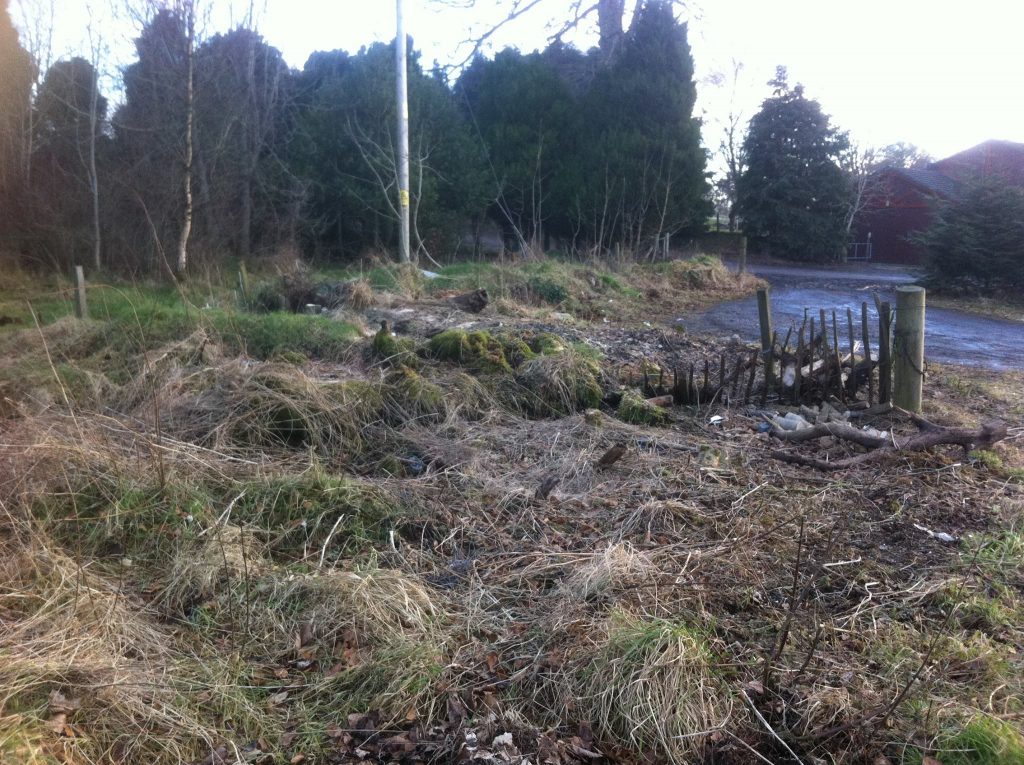
Original state of chosen site prior to clearing.
The council owns Birley Bush, it was a tree nursery, council depot and a site for tipping grave waste. The part Greener Kemnay was interested in was the grave waste tipping area and this was close to the council depot and was 80m by 30m. There is a wooded area on east and south side, with south side giving some shade but most of the potential growing land is in nearly full sun for most of the day. There are two mature trees on the site, these only provide a small amount of shade but give good focal points.
The access to the site is off a drive leading up to the main depot, this area also an overflow car park for the golf course. A lockable 12’ gate gives vehicles access, with pedestrian access on both sides of this gate. The gates lead on to an area of hard standing (a former car park), this is substantial enough to take the weight of lorries and tractor.
Getting Started
When Greener Kemnay acquire the site (see history) for a £1/year, we then had to wait for the council to flatten the area and also find a way of fulfilling the stipulations of the council of not digging into the land. We achieved this by getting 22 lorry loads of spare top soil from a housing developer who were constructing a housing estate in the village. The lorries tipped the soil just off the hard standing; it was too wet for them to go any further. Steve Ross volunteered and used his tractor to move the top soil into a large pile in the centre of garden. It took a few more months before this was spread because the ground was too water logged. A local farmer helped with the top soil by nearly covering 1/3 of the site in about a 30cm thick layer.
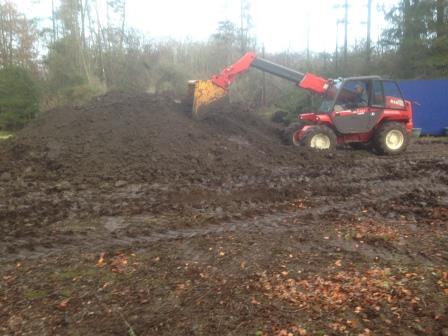
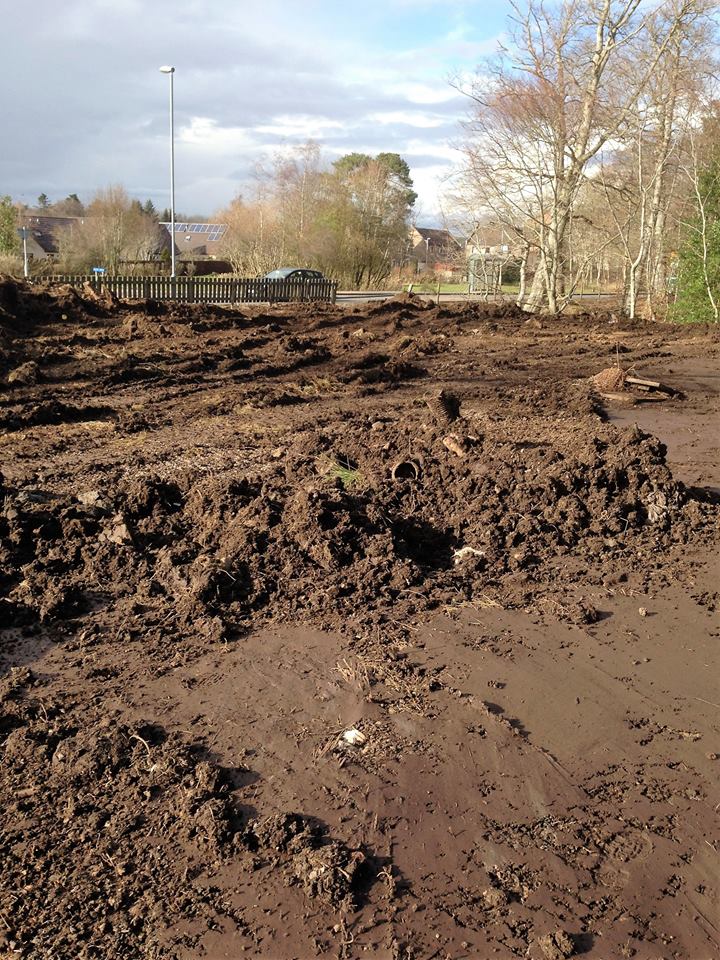
Planning the Layout of the Garden
Before we started to plan out the garden, there was decision to be made of what was wanted in the garden and also how it was going to be laid out. After a few meetings we ended up with a plan, this was in the shape of our logo, a footprint. The design included; paths, growing areas, composting area, tools store, tunnel house, a bund and the bug and hedgehog hotels (See diagram).
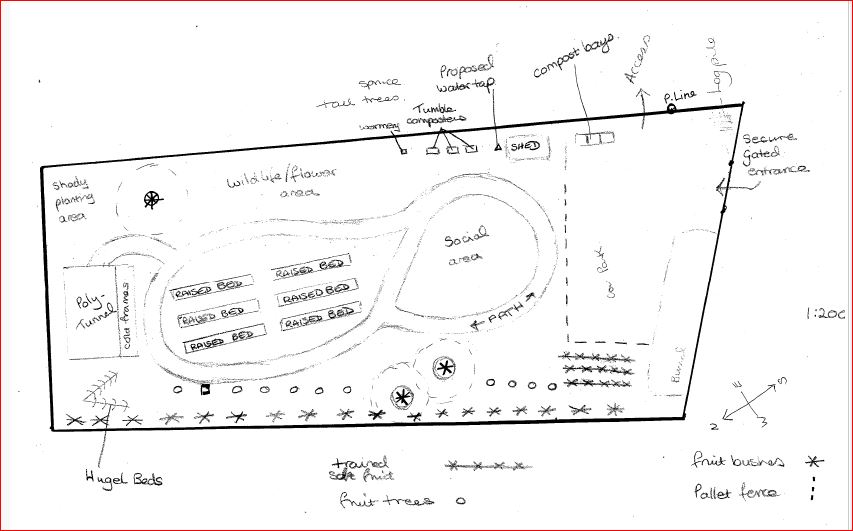
Sorting Out Storage
One of the first things on site was a container, this was bought using donated money and we found a container with a normal opening door at each end and small windows. The container has created a very secure, dry place to keep tools and other gardening equipment. It was hoped that we could hold meetings in the cabin, but it turned out that there was not enough room to do this. We used Facebook to successfully appeal for tools, flowerpots and composter. We now have wide range of good quality equipment.
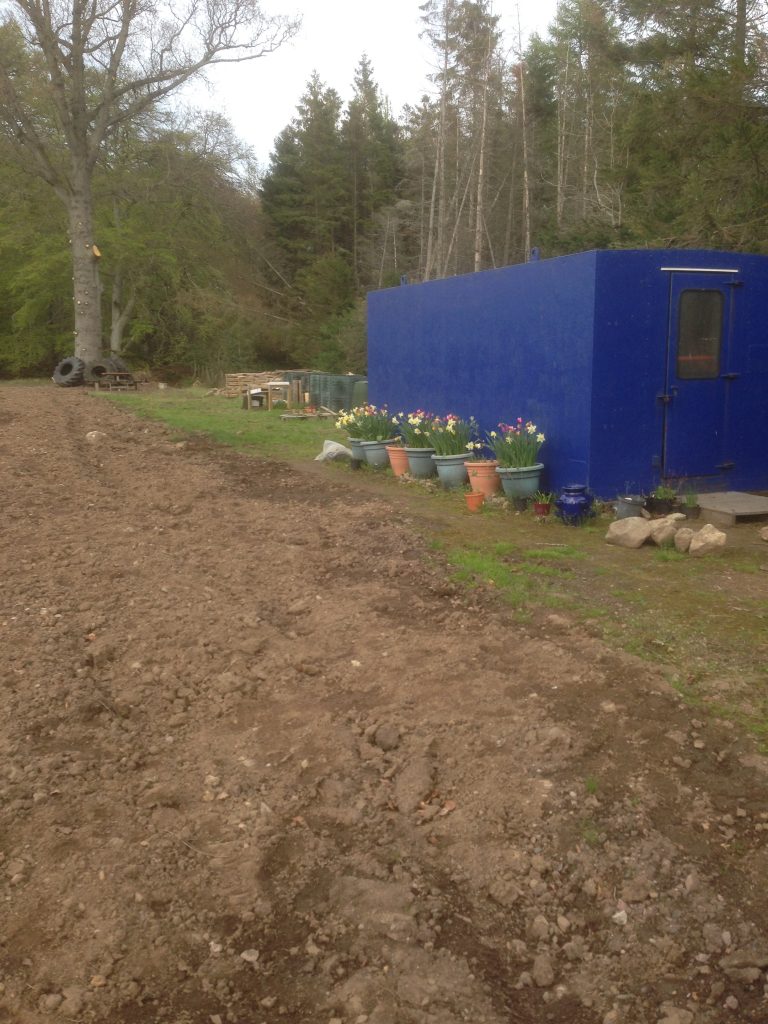
Controlling the weeds
Weeds were going to be an issue for our small group (all of who are volunteers), we worked out that we were not going to have the time or energy to keep on top of them and we decided on weed suppression. We received some weed suppression matting from the Aberdeen Western Periphery Route, this had just been completed and they were giving away material they had over ordered. We had enough to cover 1/2 of the site, this was laid under the paths, around the raised beds and other areas we wanted to keep weed free. The top soil had come with a lot of large stones, these were used to mark out the paths and hold down the mat at the edges. Wood chipping from a local tree surgeon were placed over the top of the mat, around the raised beds and on the non-growing areas. The paths took longer to cover, the funds had to be raised for hard core and quarry dust but a few months later they were covered too.
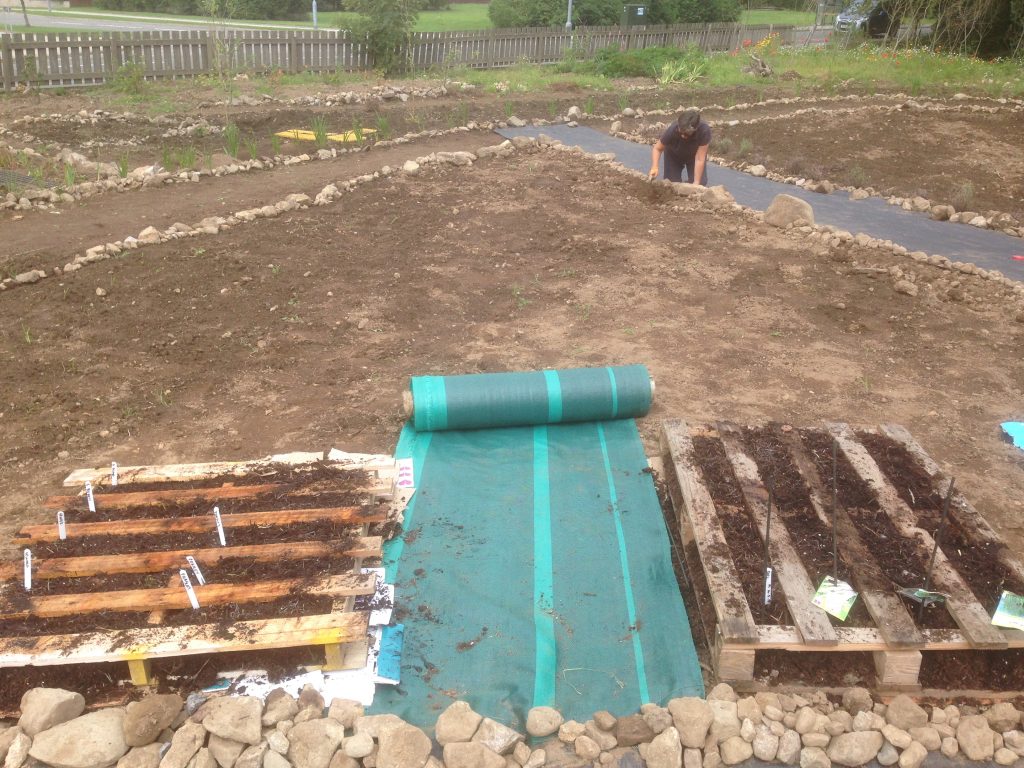
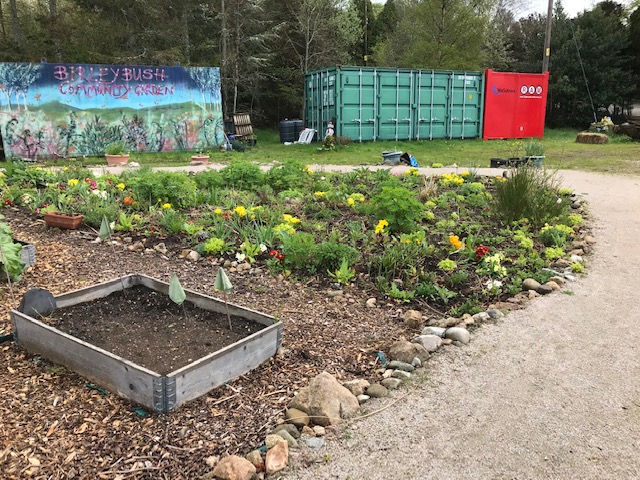
Poly Tunnel for the Garden
We wanted to grow tender plants, to do this we purchased a poly tunnel, with money from a village quiz that donates to good causes, and erected it at the north east end of the garden. To erect the poly tunnel, we needed a team effort, we luckily had good expertise from one of our team ‘Arno’ and everything went very smoothly. The plastic cover lasted 3 years, unfortunately during the devastating storm of December 2019 the covering was ripped off the frame. The poly tunnel was recovered with a very kind donation, this time we chose a different plastic and so far it has held. We are using the poly tunnel for growing tomatoes in grow bags, there are also raised beds that we grow strawberries and salad crops that we want to keep away from the deer.
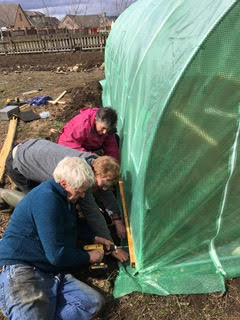



Planting
Villagers donated most of the plants for the garden, we also acquired plants from Homebase in Inverurie. For this linkup with Homebase to happen Greener Kemnay had to get a waste handling licence, as plant material counts as a waste and we accepted their garden centre threw out. This came in hippo bags that had, plants (these come with their compost as well as the pots, supporting sticks, name tags) and there was other rubbish (like plastic bags and polystyrene). Some of the plants could be salvaged and planted, a lot could not and went to composting but it was time consuming extracting the rubbish. The other problem was unloading the bags, they were put on the van with a forklift in Inverurie, this was something we did not have when the van arrived on site and we relied on human muscles. It was not always easy to have Homebase and the human muscles both at the same time.
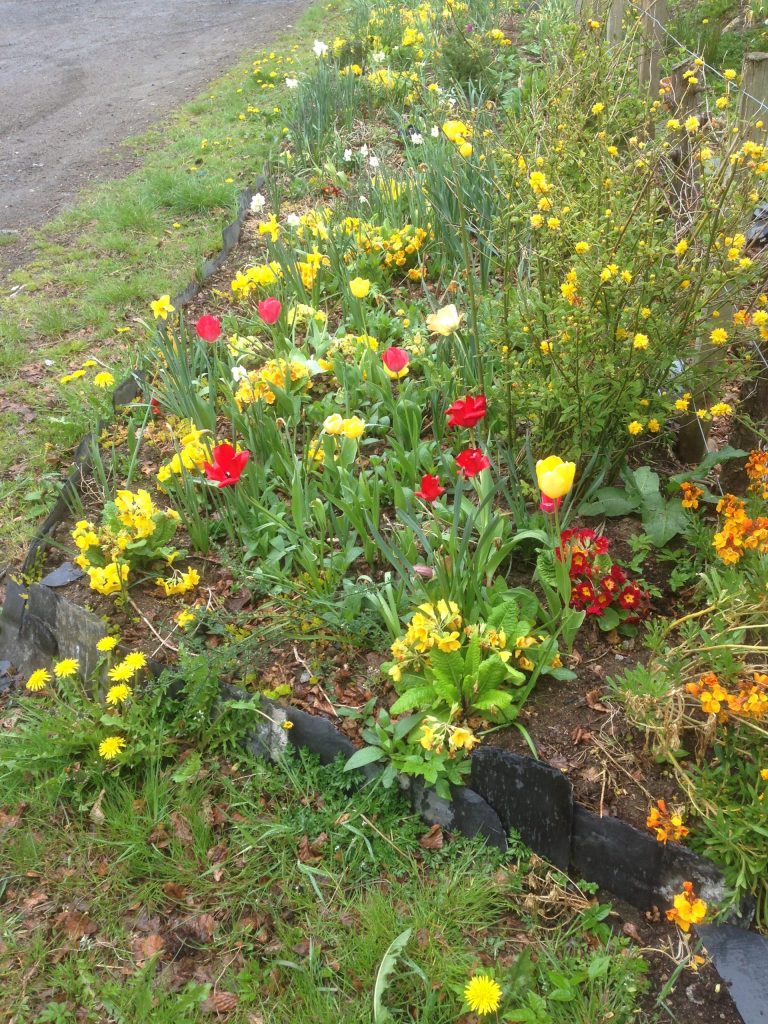
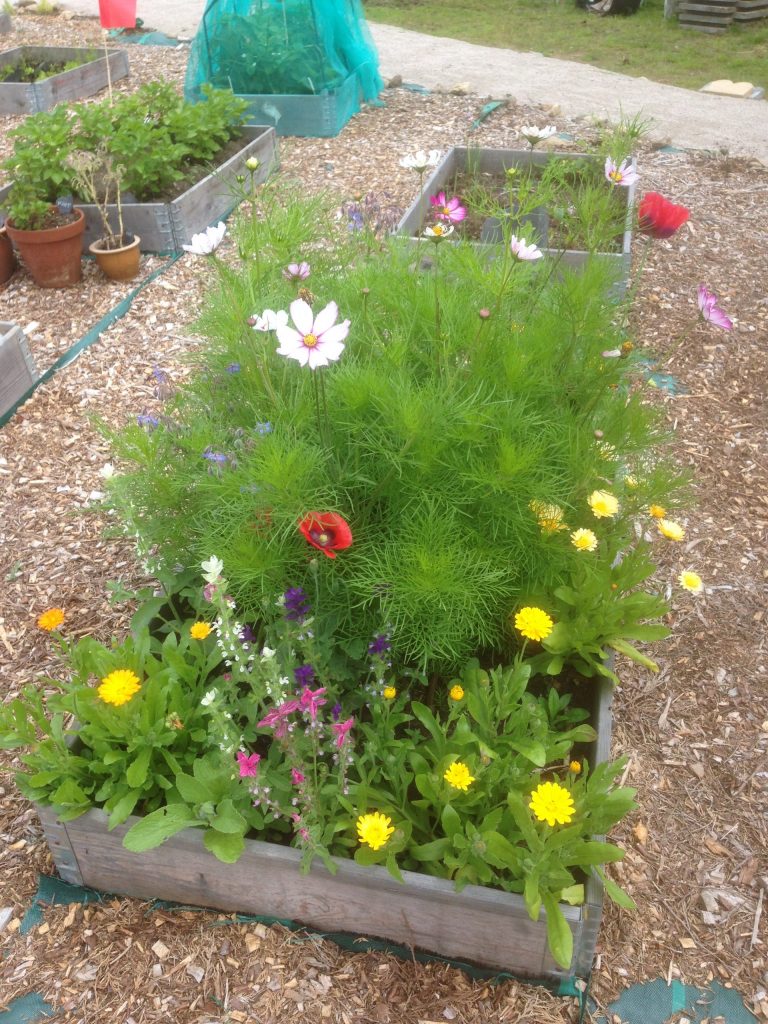
Creating Growth Spaces
The garden was set up to allow those who have no garden or little garden some growing space. For this we used pallet collars (pallet collars are designed to be used to go around pallets,) and these were filled with earth and compost. These collars are stackable, this gives those people who are having problems bending down or mobility issues and brings then close up to the growing space. We tried pallets themselves, we found it difficult to weed under the planks of wood and these were replaced with the pallet collars raised beds. To identify who was using which beds, the collars are numbered, using painted slates and a register and map was made. Along with the raised beds areas, we set aside an area of three larger plots of about 5m x 5m and these were given to people who wanted to grow more vegetables.
All the gardeners had to be very selective about what they grow, they discovered that deer will eat the non-smelly vegetables (bean, peas. carrots, beetroot etc) and deer would not touch onions, potatoes, artichoke etc. To try to preserve the later from being eaten, fencing was placed around the larger growing spaces, and at first these were not built high enough and they needed to be over a metre to create a deer proof barrier.
Composting our Waste
We established a composting area with all the compost bins we had been given. The site we choice, was close to the growing area and with easy access for the Homebase waste. We started off with filling up all the bins, then leaving them to compost down but as the number of growers increased and the garden matured we needed to set up a system where garden waste to be put. The bins are now numbered, the growers know where to put the different materials and which bin to extract compost from.
Other compostable waste has been used, such as pet rabbit and guinea pig litter and there is a coffee granules collection from the village’s cafes. All the compost made, is being used on the site in the ground or in the raised beds.
Water
The one thing the site lacks is a water supply, to help with this we obtained two IBC (Intermediate Bulk Containers) and these were set on pallets. To have these filled, we had an arrangement with the council depot close to the site (see map) and they ran a large bore hose the 150m through the woods. This was not going to be a long term solution, as it required the good will of the depot and someone from Greener Kemnay being there at the time the depot wanted to fill them. That person also needed to be there all the time to see when IBC were full.
A mains supply was also explored, this was going to be too costly and not easy to do. At this time Greener Kemnay were asked if a Youth shed could be placed in the garden, this we agreed to and a shed was bought. We sited the shed close to the IBC, adding some guttering and this channelled the rain water into the IBC. This system was not able to capture all the rainwater, as the guttering did not have a greater enough fall and water was lost from the gutters. We did explore dropping IBC but this would have proven difficult to get the watering cans underneath the taps.
We had an opportunity to raise the roof a year later, when the same storm that damaged the poly tunnel took the roof off the Youth Shed as well. We raised the roof by 30cm, this repair was also favourable for use of the Youth Shed as before it was too low inside for the users and the gardens benefited as more of the water was caught.
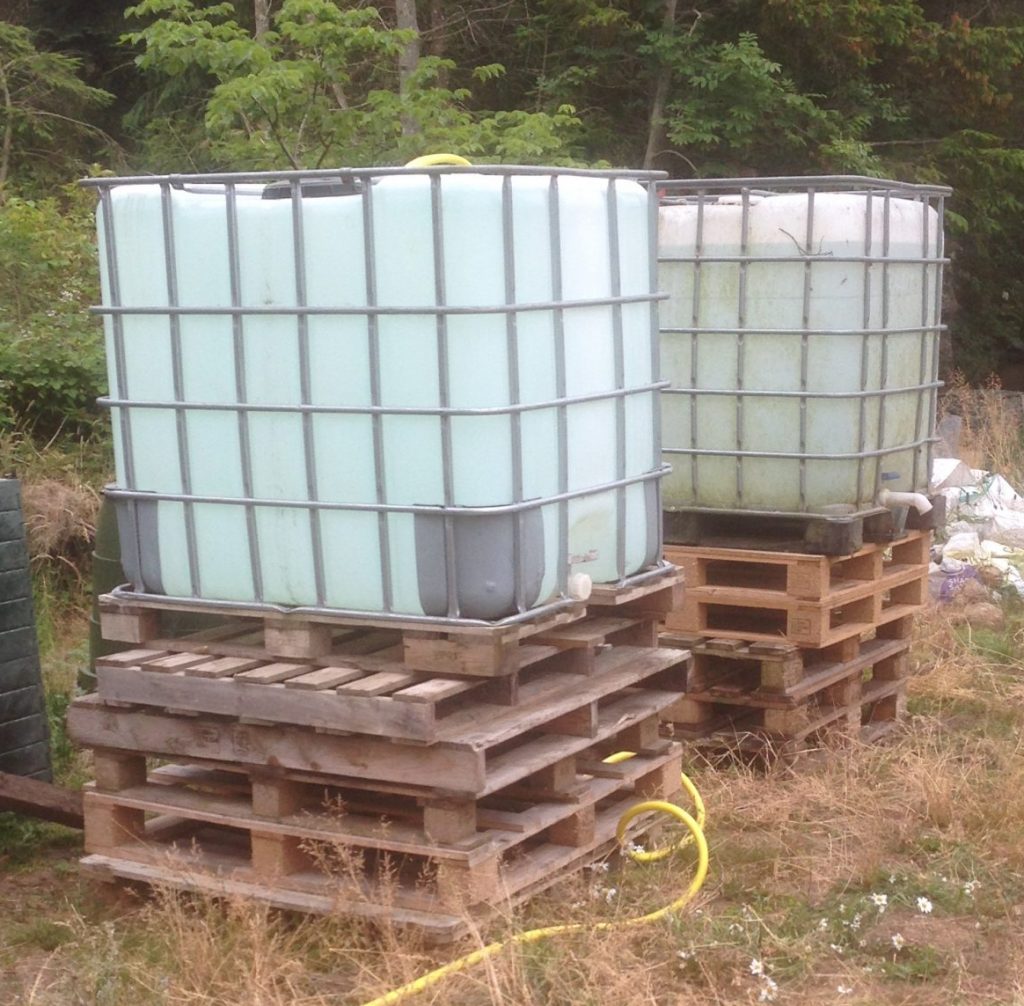
We have used the IBC to pipe water to a series of water butts positioned by the ploy tunnel, these needed to be topped up over a summer and at present the two rain feed IBC have managed to cope with our water needs.
Improving Access
As was said above, the only access to the garden was via a large gate with pedestrian route either sided and this was fine for anyone who was travelling to the garden by car as there was good parking. If anyone walk to the garden from the village you walk past the garden to get to the gate and this was thought to putting off visitors to the garden. We have put a gate on the roadside, this now allows the villagers easier access to the garden and in turn increased its footfall.
When sighting the new gate; we considered what was on the roadside at present e.g. road signs and lamppost and also what the conditions were like on the garden side e.g. marsh and rough ground. Once a position was chosen for the gate; two sections of the original garden fence were removed, then two large posts where erected about 1 metre away from the pavement and these were far enough apart from each other to allow a wheelchair or pushchair though. We then filled in the gap between the original fence and the large posts with the original fences that was removed in the first place. For a gate, we opted for a double one made by a local blacksmith, he decorated it with flowers and welcome to Community Garden on it.
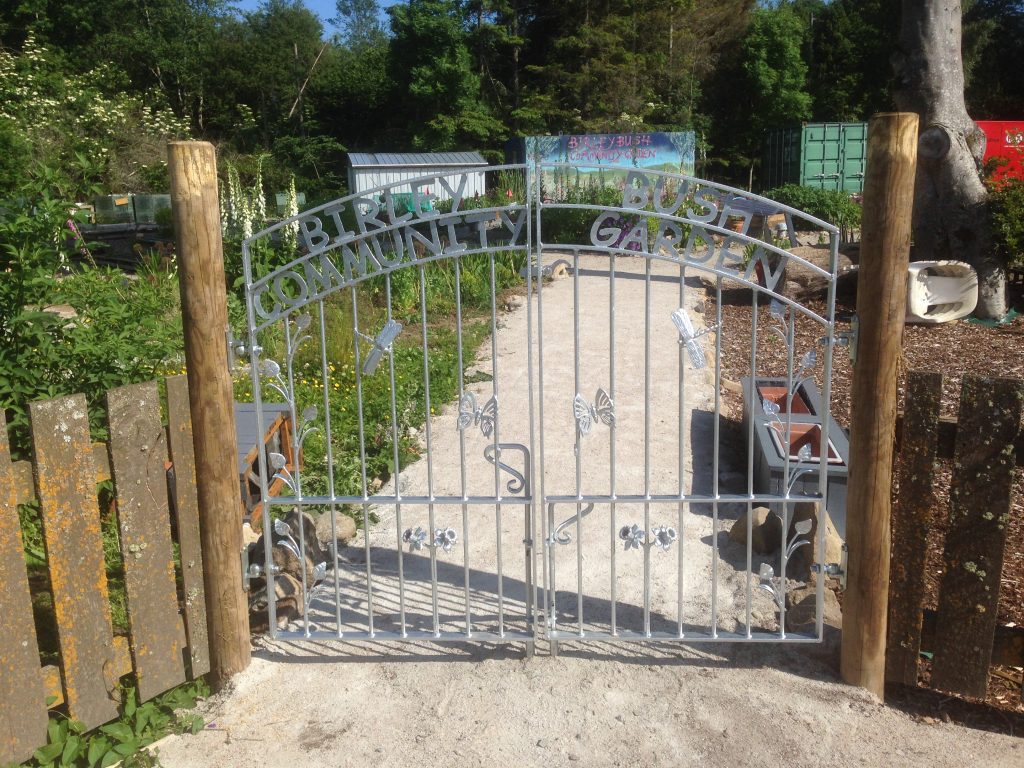
Attracting birds to the garden
A bird feed area was established quite early on in conception of the garden, it was placed in a reasonable quiet area of the garden and close to trees and bushes. We were donated feeders, a bird house/table and a bin to put the food into. The bird feed is kept in a small wheelie bin, with a weight on top of the lid and this keeps the food dry.
Workdays and events
Early on in the gardens history we saw the need to have activity days, these were focusing on getting jobs done in the garden. These are held on the second Saturday of the month, we encourage as many people to come as possible to give as long time that they can spare. The activity day start at 10am and goes on to 2pm, with a tea break and lunch. We are always looking for ways to increase participation in these days, as numbers can be low and not always easy to get the work done. A WhatsApp group was set up, this has increased our number of volunteers and along with this it has improve the communication to members. The WhatsApp group allows the people to advertise they are going down to the gardens, to see if any other person would like to go and the jobs needing to be done can be submitted.
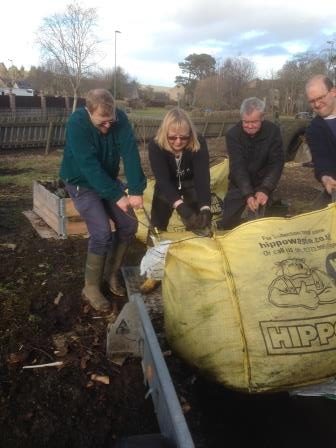
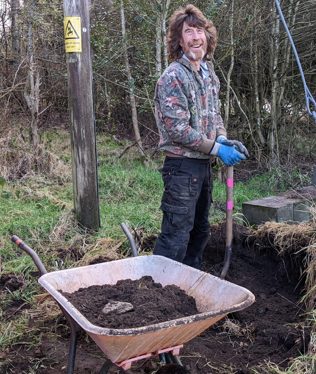
Along with the activity days we have a yearly open event at the garden, either in the spring ‘May’ or at the end of summer ‘September’ these are put on to try to boost participation in the garden. To attract people to these events we put on activities, such as; invited speakers, other like minded organisations, activities for the kids and adults, plant sales, Community Council, giving away cooked food on the barbecue, mocktails and teas and coffees. How successful these are, very much depends on the weather.
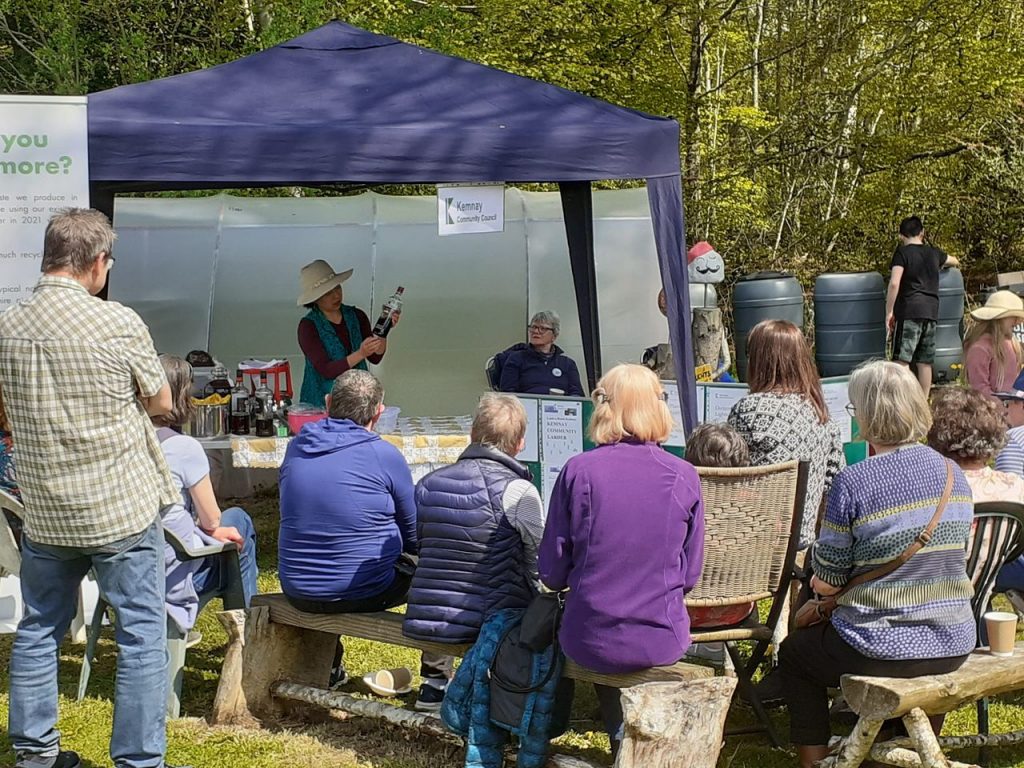
Encouraging other groups to use the garden.
We have had some success in attracting groups to the Community Garden, such as youth groups, senior citizen and walking groups. The Guides made it their home, during lockdown when they could only meet outdoors, the Rainbows, Brownie and Guides met there and the leaders put on activities they could do in the gardens whatever the weather.
Attracting Non Gardeners
The gardens has now become a destination, for those who are doing the Kemnay Steens walk (See Kemnay Steens Art project), these Steens are located around Kemnay village and its surrounding area. The gardens has a Steen, it is in the middle of the garden and is starting to look like it’s always been there. This Steens trail has been competed by locals and visitors, even after 2 years it is still very popular.
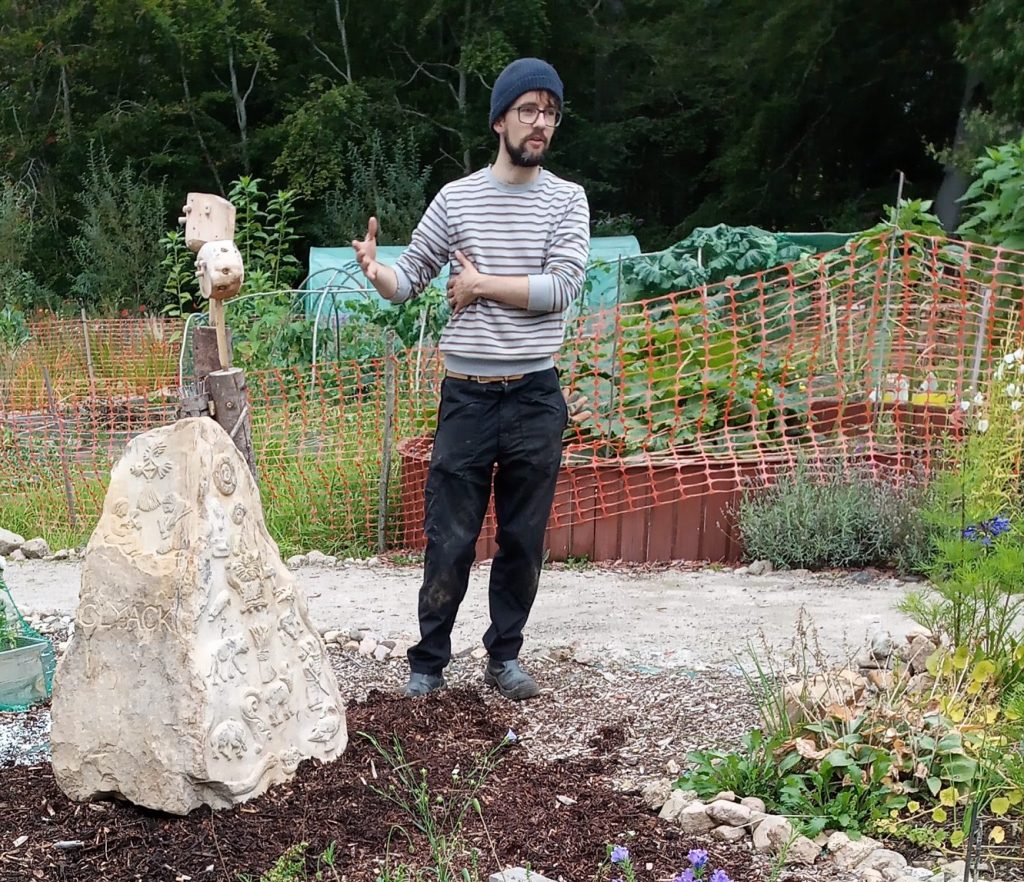
Another way we have increased footfall, was by setting up a boules piste in the gardens on the old car park that is situated at the west end of the garden. The Trustees identified that there was a need for a boules piste in Kemnay, as there are a large amount of teams that came from Kemnay who play in the very successful Monymusk (a village near Kemnay) Boules Tournament.
When the decision was made to set the piste, we invited the person who set up the Monymusk piste and he helped us identify a good site (the old car park). Then we advertised for interested party’s to build the piste and they formed a group who are now responsible for looking after the piste. This group has had great help from one of the Scottish players (who lives in the village), he has given advice and helped with its construction.

The boules group created a good playing surface by first clearing all the top surface off 12 x 8m area and then put a 40mm preserved wood border around it. As this area was a former car park there was only 20 tons of hard core need, this was a donation by a nearby house builders and spread to just to the edge of the wood border. The hard core was also placed on weed suppressing mats to create a path around 3 of the sides. To get a good playing surface a layer of sharp sand covered the hard core and a vibrating plate was used to bash down the sand. The group erected a spectators leaning poll, this gives a place to sit and watch and there is also a sign with rules and a container for a set of boules in it.
Management
The garden is managed by a small group of gardening enthusiasts, they meet once a month to decide on the jobs that need to be done and organise the open events. This is now a sub group of Greener Kemnay, feeds back its minutes of its meeting and has a representative at the Trustees once a months meeting.
Keep Scotland Beautiful
Keep Scotland Beautiful has a beginners category for villages and neighbourhoods called It’s Your Neighbourhood. The Kemnay Community Association were the recipients of the annual allocation of bedding plants but as time went on the Community Council took on this role. In 2020 as well as planting the boxes in the High Street volunteers took on the roundels at Bremner Way and opposite Littlewood Court. Birley Bush Community Garden established in 2017 is a colourful habitat for all to enjoy, Kemnay and District Bee Group have an apiary at Dalmadilly and more recently the Academy pupils have planted bulbs, perennials and tree whips along the new river path. Replacement planting at Littlewood Court was needed and volunteers extended the work to include the rail bridge, the war memorial and the seating area on Station Rd. Several villagers contributed plants no longer needed from their gardens.
Sadly budget constraints within the Council curtailed their bedding plant offer for 2025 and the offer has now been withdrawn completely as the Council could not afford a replacement watering system for the nursery.
Hopefully the Birley Bush Community Garden and other village planting will fit in with the Nature and Biodiversity Theme for the 2025 Its Your Neighbourhood Awards
What is next?
The Greener Kemnay Trustees would like to expand the gardens to the south into the woods, these need managing, as there are a lot of fallen pines and there is potential to create a woodland walk. This area does include a bit of flat land, which could be used for allotments and fulfil a need for more growing spaces in the village.
We would like to continue to attract more people to the gardens, we have been looking into putting a cycling maintenance station in as the gardens are on a busy route for riders.
We would also like to put in a composting toilet within the site and sort out a more permanent water supply.
Recent pictures from the Community Garden.
